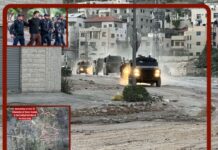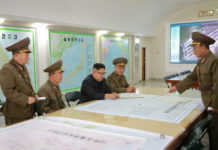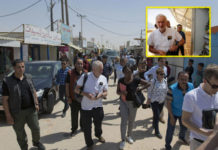
The US Treasury Department says it has stepped up efforts to counter Sanaa forces’ operations in the Red Sea, adding that turning the war in Gaza into a regional conflict will pose a threat to the global economy.
In the meantime, some indications have leaked out on the exchange formula under discussion between Hamas and Israel, source New York Times: 5 Israeli soldiers kidnapped in exchange for 15 “heavy” terrorists; 7 kidnapped Israeli civilian women whose release Israel seeks under previous plan – in exchange for 21 Palestinian prisoners; 6 Palestinian prisoners for every Israeli kidnapped over 50 years old; 12 Palestinian prisoners for every additional injured Israeli kidnapped. And while the negotiators continue their work with the mediation of Qatar and Egypt, US President Joe Biden said in his interview with NBC that: “The path chosen by the Netanyahu government will lead Israel to lose the support of the whole world” . Israel, on February 27, agreed to the release of 400 Palestinian prisoners, including a certain number of people already convicted. Hamas in a press note said that Biden’s statements were premature, there are still many problems to be solved.
On the 27th, many images were posted in the social sphere in which food items could be seen parachuting onto the coasts of Gaza. The military spokesperson of the Egyptian Armed Forces said that: “Egypt, Jordan, the United Arab Emirates, Qatar and France have carried out an operation to send tons of humanitarian aid to the Gaza Strip”.
Ministry of Health spokesperson Dr. Ashraf Al-Qudra reported that: “We have started monitoring child deaths due to drought and malnutrition in northern Gaza. Two children died due to dehydration and malnutrition in Kamal Adwan Hospital. Dehydration and malnutrition will kill thousands of children and pregnant women in the Gaza Strip. We call on international institutions to conduct a comprehensive medical investigation of shelters to monitor and treat those suffering from dehydration and malnutrition and to prevent a humanitarian catastrophe. United Nations institutions have moral and functional responsibilities to protect children and women and provide all means of survival from the famine affecting the Gaza Strip. We call on the international community to stop the crimes of genocide committed by the Zionist occupation in the Gaza Strip through attacks, starvation and epidemics.”
The Times of Israel reported that the Israeli military detected the activation of Hamas phones using Israeli SIM cards six hours before the October 7 attack. From this publication it appears that the Israeli army knew about the attack in advance and, most likely, allowed it.” The Israeli media also reported that: “A new building is opened in Ashdod to treat thousands of Israeli soldiers suffering from post-war trauma.”
War Minister Yoav Gallant warned that: “We monitor attempts by Iran, Hezbollah and Hamas to turn Ramadan into the second phase of 7/10 and set fire to the region.”
IDF Chief of Staff General Herzi Halevi threatens to impose a higher price for Hezbollah’s attacks: “Hezbollah decided on the evening of October 7 to join. For this it will have to pay a very high price,” he said Halevi, Feb. 27 during a war assessment at the 146th Division headquarters.
This base was attacked on February 27 by Hezbollah, close to the time of Halevi’s visit. “I think that if we do the right thing, the residents will return first of all for safety. To bring people back here with safety and quality of life, the state will be able to make an effort,”. Late in the evening of February 27, the Israeli army acknowledged that the second attack on the Meron base damaged some assets. This attack was carried out with ATGMs.
Netanyahu’s spokesman made it clear that if efforts to implement Resolution 1701 fail, the military option will remain and Hezbollah will pay a heavy price.
Meanwhile the Houthis have denied being responsible for cutting the undersea cables, the Sana’a government’s Ministry of Communications said: “We deny what the Israeli media promotes regarding the attack on the cables in the Red Sea.”
Yemen’s Houthi-led government said it had not caused any damage to fiber optic telecommunications cables crossing the Bab al-Mandeb Strait. The operation was carried out by anAmerican submarine that may have arrived in the area, probably to blame the Houthis for disrupting global communications traffic, and is now being used for propaganda against the Houthis in the West.
News of the cable cutting was first reported by Sky News on February 26: “The Houthis have bombed fiber optic cable lines located in the Red Sea.” “The success in targeting four cables believed to belong to the AAE-1, Seacom, EIG and TGN systems marks a major disruption of communications between Europe and Asia.”
This is an event that would have occurred at a depth of 200 metres; Ansar Allah instead showed on February 27 the first video showing the sinking of a British oil tanker near Aden after a Yemeni attack.
Also on the 27th evening the United Kingdom Maritime Trade Office (UKMTO) reported a Houthi attack on shipping in the southern Red Sea, west of Hodeidah.
On February 28, the German frigate F221 Hessen deployed in the Red Sea as part of the EU naval mission to protect shipping, repelled an attack by Iran-backed Houthi militias in Yemen for the first time, according to DPA sources.
Also on February 28 in Yemen, the isolated tribes of Bani Amr in the district of Al-Hayma Al-Dakhiliyah, Sana’a governorate, announced tribal mourning and general mobilization, in solidarity with the Palestinian people and in victory for the oppression of the people of Gaza.
And now a look at the situation between Israel and Hamas updated at 4.30pm on February 28.
The Israeli newspaper Yedioth Ahronoth states: “The Israeli army is losing a good number of leaders and fighters and has thousands of wounded. We must mobilize the ranks. We will end the year with 12,000 disabled Israeli soldiers.”
Meanwhile, the conflict in southern Lebanon flares up. Hamas’ military wing said it fired 40 rockets from southern Lebanon towards northern Israel in the Kiryat Shmona area. Israeli media: they also spoke of rockets that fell in Beit Hillel, in the Galilee, on the border with Lebanon. Lebanese missiles reach 16 kilometers inside the Galilee for the first time. On December 27, Israeli press reports said more than 100 missiles had been fired from Lebanon towards northern Israel in the last 24 hours. Mutual attacks on the southern Lebanon border continued throughout the day on February 28.
The Islamic Resistance in Lebanon says it is using anti-armor missiles against the Israeli base in Meron. According to Hezbollah, “for the second time, we targeted the Meron command, control and air surveillance base with a batch of anti-armor missiles, which led to the damage and complete destruction of part of its equipment and technical equipment and espionage.”
In response, Israel attacked the outskirts of the village of Beit Leaf in southern Lebanon. Further Israeli attacks targeted the Khraybeh area near Khiyam. Altria attacks were reported in the village of Ebl Seqeh.
The Israelis flew armed US-made, Israeli-operated F-15 jets in areas over southern Lebanon and Beirut. Numerous sonic booms were reported everywhere, causing distress to thousands of civilians. On February 28, Israeli warplanes carried out an air attack, hitting the city of Zaloutiyeh in the western sector of southern Lebanon with missiles.
The Israeli army is conducting a combing operation in the vicinity of Birkat Risha, on the Lebanese-Israeli border, opposite the town of Marwahin. Sirens sounded in northern Israel in Efen Menachem, Goren, Zarait and Shomera in the Western Galilee.
More clashes recorded in northern Gaza. The Al-Quds Brigades and the Al-Nasser Salah al-Din Brigades targeted Israeli soldiers and military vehicles in the vicinity of the Eastern Cemetery, east of Jabalia.
In central Gaza, clashes continued in the Zaytoun neighborhood axis between the Qassam mujahideen and the Nahal Brigade of the Israeli army. As of February 27, a military statement released by the Storm Forces, the military wing of the Fatah movement, informed of attacks against Israeli soldiers in the vicinity of the Stars Hall, south of the Zaytoun neighborhood in Gaza City. Photos show on February 28 the Mujahideen Brigades targeting an Israeli bulldozer with a “Sa’ir” in the southern axis of the Al-Zaytoun neighborhood. Events of February 26: Clashes and ambushes by Hamas allies against Israeli soldiers in the Dawlat Interchange, south of the Zaytoun neighborhood of Gaza City. Israeli bombing recorded on Nuseirat field, in the center of the Gaza Strip.
In southern Gaza, another day of clashes in the Khan Yunis area. “The city of Khan Yunis witnesses intense clashes with various types of military weapons between the Qassam Mujahideen and the invading enemy forces.” We read it in a Qassam post. The Israelis fired intensely around the Nasser Medical Complex in Khan Yunis. In particular, the third floor of the hospital would have been destroyed.
Clashes were also recorded near the Al-Shafi’i mosque, west of the city of Khan Yunis. And more clashes in the Abasan Al-Kabira area, east of Khan Yunis.
On February 27, the Association of Palestinian Prisoners reports 15 arrests of Palestinians in the West Bank. The Israelis arrested a number of Gaza and West Bank workers from the town of Barta’a, whose numbers and identities were not known. On the night of February 27, a huge fire devoured the royal factory in Hebron. On the afternoon of February 28, Israeli soldiers carried out a raid on a series of houses belonging to the families: Al-Shafi’i, Radwan and Sufyan.
Shootings have been reported since February 26 on the Egyptian border with Palestine.
Antonio Albanese e Graziella Giangiulio

















